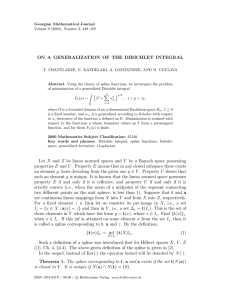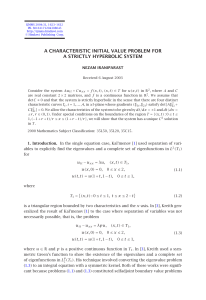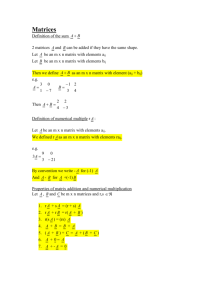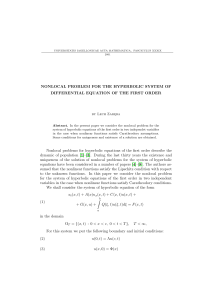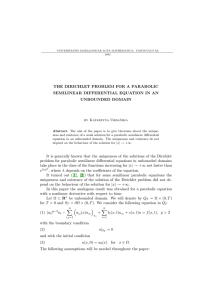THE INITIAL-BOUNDARY VALUE PROBLEM FOR SOME PSEUDOPARABOLIC SYSTEM IN UNBOUNDED DOMAIN
advertisement
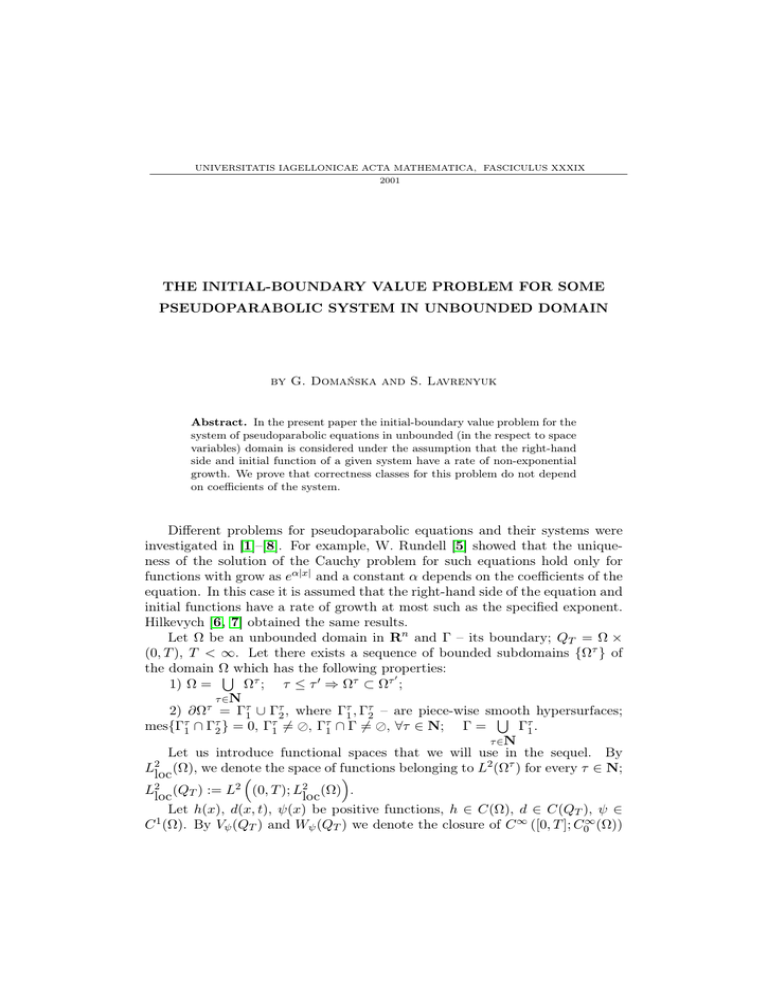
UNIVERSITATIS IAGELLONICAE ACTA MATHEMATICA, FASCICULUS XXXIX
2001
THE INITIAL-BOUNDARY VALUE PROBLEM FOR SOME
PSEUDOPARABOLIC SYSTEM IN UNBOUNDED DOMAIN
by G. Domańska and S. Lavrenyuk
Abstract. In the present paper the initial-boundary value problem for the
system of pseudoparabolic equations in unbounded (in the respect to space
variables) domain is considered under the assumption that the right-hand
side and initial function of a given system have a rate of non-exponential
growth. We prove that correctness classes for this problem do not depend
on coefficients of the system.
Different problems for pseudoparabolic equations and their systems were
investigated in [1]–[8]. For example, W. Rundell [5] showed that the uniqueness of the solution of the Cauchy problem for such equations hold only for
functions with grow as eα|x| and a constant α depends on the coefficients of the
equation. In this case it is assumed that the right-hand side of the equation and
initial functions have a rate of growth at most such as the specified exponent.
Hilkevych [6, 7] obtained the same results.
Let Ω be an unbounded domain in Rn and Γ – its boundary; QT = Ω ×
(0, T ), T < ∞. Let there exists a sequence of bounded subdomains {Ωτ } of
the domain ΩSwhich has the following properties:
0
1) Ω =
Ω τ ; τ ≤ τ 0 ⇒ Ω τ ⊂ Ωτ ;
τ ∈N
2) ∂Ωτ = Γτ1 ∪ Γτ2 , where Γτ1 , Γτ2 – are piece-wise smooth
S τ hypersurfaces;
mes{Γτ1 ∩ Γτ2 } = 0, Γτ1 6= , Γτ1 ∩ Γ 6= , ∀τ ∈ N; Γ =
Γ1 .
τ ∈N
Let us introduce functional spaces that we will use in the sequel. By
L2loc (Ω), we denote the space of functions belonging to L2 (Ωτ ) for every τ ∈ N;
L2loc (QT ) := L2 (0, T ); L2loc (Ω) .
Let h(x), d(x, t), ψ(x) be positive functions, h ∈ C(Ω), d ∈ C(QT ), ψ ∈
C 1 (Ω). By Vψ (QT ) and Wψ (QT ) we denote the closure of C ∞ ([0, T ]; C0∞ (Ω))
230
(the set of infinitely differentiable functions) in the norms
1
2
#
Z "
n
X
kukVψ (QT ) =
h(x)|ut |2 + d(x, t)|u|2 +
|uxi |2 + |uxi t |2 ψ(x)dxdt
i=1
QT
and
1
2
Z
kukWψ (QT ) =
|u|2 ψ(x)dxdt
QT
respectively and by Uψ (Ω) – the closure of C0∞ (Ω) in the norm
"
1
#
2
Z
n
X
2
2
kukUψ (Ω) =
(h(x) + d(x, 0))|u| +
.
|uxi | ψ(x)dx
i=1
Ω
The problem
H(x)ut −
−
(1)
n
X
(Aij (x)uxi t )xj −
i,j=1
n
X
n
X
(Bij (x, t)uxi )xj −
i,j=1
Ci (x, t)uxi + D(x, t)u = F (x, t),
i=1
(2)
u|Γ×[0,T ] = 0,
(3)
u|t=0 = u0 (x)
is considered in QT . Here Aij , Bij , Ci , D, H are square m × m matrices;
u = (u1 , ..., um )t , F = (F1 , ..., Fm )t ; (·, ·) is a scalar product in Rm ; | · | is a
norm in Rm .
Definition. By a solution of the problem (1) – (3) we mean such a function
u ∈ Vψ (QT ) which satisfies the integral equality
Z
n
n
X
X
(H(x)ut , v) +
Aij (x)uxi t , vxj +
Bij (x, t)uxi , vxj −
i,j=1
QT
(4)
−
n
X
i=1
i,j=1
#
Z
(Ci (x, t)uxi , v) + (D(x, t)u, v) dxdt =
(F (x, t), v) dxdt
QT
for every function v ∈ C0∞ (QT ) and fulfil the condition (3) almost everywhere
in Ω.
231
We say that the coefficients of the system (1) fulfil the conditions (A), (B),
(D), (H) if:
(A) :
a
n
X
|ξ i |2 ≤
i=1
n
X
Aij (x)ξ i , ξ j , a > 0, ∀x ∈ Ω;
i,j=1
Aij (x) = Aji (x), Aij (x) = Atij (x), ∀x ∈ Ω, ∀i, j ∈ {1, ..., n};
(B) :
Aij ∈ L∞ (Ω), ∀i, j ∈ {1, ..., n};
n
n
X
X
b
|ξ i |2 ≤
Bij (x, t)ξ i , ξ j , b > 0, ∀(x, t) ∈ QT ;
i=1
i,j=1
t
Bij (x, t) = Bji (x, t), Bij (x, t) = Bij
(x, t), ∀(x, t) ∈ QT ,
∀i, j ∈ {1, ..., n};
Bij ∈ L∞ (QT ), Bijt ∈ L∞ (QT ), ∀i, j ∈ {1, ..., n};
(D) :
d(x, t)|ξ|2 ≤ (D(x, t)ξ, ξ) ≤ θd(x, t)|ξ|2 , ∀(x, t) ∈ QT ;
∞
D ∈ L∞
loc (QT ), Dt ∈ L (QT );
(H) :
h(x)|ξ|2 ≤ (H(x)ξ, ξ) ≤ θh(x)|ξ|2 , ∀x ∈ Ω; H ∈ L∞
loc (Ω);
for all vectors ξ, ξ i , ξ j in Rm , 1 ≤ i, j ≤ n; θ > 1.
For the sake of simplicity, let us set
 = sup
n
X
Ω i,j=1
n
X
kAij (x)k2 ;
QT i=1
n
X
kBij (x, t)k2 ;
QT i,j=1
2
kCi (x, t)k ;
Ĉ = sup
B̂ = sup
ωc = Ĉ sup
QT
1
1
+
h(x) d(x, t)
.
Theorem 1. Let the coefficients of the system (1) satisfy conditions (A),
(B), (D), (H), Ci ∈ L∞ (QT ), i = 1, . . . , n and let there exists a positive function
ψ ∈ C 1 (Ω) such that for every x ∈ Ω
n
X
ψx2i (x)
(5)
≤ γ min h(x), inf d(x, t) , γ > 0.
ψ 2 (x)
[0,T ]
i=1
Let also  <
one solution.
a
,
4n2 γ
ωc < ∞. Then the problem (1) – (3) has no more than
Proof. Let u1 , u2 be solutions of the problem (1) – (3). For each of them
we write the integral equality (4), deduct these equalities and put u = u1 − u2 ,
232
v = (ut + u)ψ(x)e−µt , µ > 0. Using the assumptions, we estimate
Z
(H(x)ut + D(x, t)u, ut + u) ψ(x)e−µt dxdt ≥
I1 =
QT
Z d1 (x, t) µ
2
2
≥
h(x)|ut | + d(x, t) −
+ (h(x) + d(x, t)) |u|
2
2
QT
I2
ψ(x)e−µt dxdt;
Z X
n =
Aij (x)uxi t + Bij (x, t)uxi , ((ut + u)ψ(x))xj e−µt dxdt ≥
QT i,j=1
Z "
≥
nÂ
a−
δ1
X
n
QT
×
n
X
i=1
I3 =
2
|uxi t | +
i=1
nB̂
b1 µ
+ (a + b) −
b−
2
2
δ1
!
×
#
n
2 (x)
X
ψ
xi
|ut |2 + |u|2 ψ(x)e−µt dxdt;
|uxi |2 − nδ1
ψ 2 (x)
i=1
Z X
n
(Ci (x, t)uxi , ut + u) ψ(x)e−µt dxdt ≤
QT i=1
Z "
≤
Ĉ
2δ2
1
1
+
h(x) d(x, t)
QT
X
n
i=1
nδ2
|uxi |2 +
h(x)|ut |2 + d(x, t)|u|2
2
ψ(x)e−µt dxdt
and obtain
Z "
nÂ
a−
δ1
QT
!
n
X
|uxi t |2 +
i=1
nB̂
Ĉ
b1 µ
+ b−
+ (a + b) −
−
2
2
δ1
2δ2
1
1
+
h(x) d(x, t)
! X
n
|uxi |2 +
i=1
n
X
ψx2i (x)
µ
+ d(x, t) −
+ (h(x) + d(x, t)) − nδ1
−
2
2
ψ 2 (x)
i=1
!
#
n
2 (x)
X
ψ
nδ2
nδ
2
xi
−
d(x, t) |u|2 + h(x) − nδ1
−
h(x) |ut |2
2
ψ 2 (x)
2
d1 (x, t)
i=1
(6)
−µt
ψ(x)e
dxdt ≤ 0,
#
233
where coefficients b1 and d1 (x, t) depend on kBijt (x, t)k and kDt (x, t)k, respectively. Number δ1 is chosen so that
2n
Â
1
< δ1 <
.
a
2nγ
Let µ and δ2 be such that
1 − 2nδ1 γ − nδ2 ≥ 0,
d(x, t) − d (x, t) + µ (h(x) + d(x, t)) − d(x, t) (2nδ1 γ + nδ2 ) ≥ 0,
1
2nB̂
ωc
−
≥ 0.
δ1
2δ2
≤ 0, i.e. u = 0 almost everywhere. The theorem is
b − b1 + µ(a + b) −
Then (6) implies kukVψ (QT )
proved.
Theorem 2. Let the
coefficients of the system (1) fulfil all the assumptions
of Theorem 1, h1 + d1 F ∈ Wψ (QT ), u0 ∈ Uψ (Ω). Then the problem (1) – (3)
has at least one solution.
Proof. Let us consider the problem
n
n
X
X
H(x)ut −
(Aij (x)uxi t )xj −
(Bij (x, t)uxi )xj −
−
(7)
i,j=1
n
X
i,j=1
Ci (x, t)uxi + D(x, t)u = F ∗ (x, t),
i=1
(8)
u|Γ∗ ×[0,T ] = 0,
(9)
u|t=0 = u∗0 (x),
in the domain Q∗T = Ω∗ × (0, T ) where Ω∗ ∈ {Ωτ }, Γ∗ is a boundary of Ω∗ .
Here
u0 (x), x ∈ Ω∗ ,
F (x, t), (x, t) ∈ Q∗T ,
∗
∗
u0 (x) =
F (x, t) =
∗
0, (x, t) ∈ QT \ QT ;
0, x ∈ Ω \ Ω∗ .
u∗
By the solution of
the problem (7) – (9) we mean a function
1
1
∗
∈ H (0, T ); H0 (Ω ) that satisfies the integral equality
Z
n
n
X
X
(H(x)ut , v) +
Aij (x)uxi t , vxj +
Bij (x, t)uxi , vxj −
i,j=1
Q∗T
−
n
X
i=1
i,j=1
#
Z
(Ci (x, t)uxi , v) + (D(x, t)u, v) dxdt =
Q∗T
(F ∗ (x, t), v) dxdt,
234
for every function v ∈ C ∞ ([0, T ]; C0∞ (Ω∗ )) and fulfils the condition (9) almost
everywhere in Ω∗ . We shall approximate a solution of (7) – (9) using the
Galerkin method. Let {ϕ∗,k (x)} be a basis of H01 (Ω∗ ). We orthogonalize this
system with respect to the scalar product
Z
(u, v) =
(H(x)u, v) +
N
P
k=1
Aij (x)uxi , vxj dx
i,j=1
Ω∗
and put u∗,N =
n
X
∗,k
N
cN
k (t)ϕ (x) where ck (t), k = 1, ..., N may be found from
the system of equations
Z
n X
∗,k
∗,k
H(x)u∗,N
Aij (x)u∗,N
xi t , ϕxj (x) +
t , ϕ (x) +
i,j=1
Ω∗
+
n
X
∗,k
Bij (x, t)u∗,N
xi , ϕxj (x)
i,j=1
−
n X
∗,k
Ci (x, t)u∗,N
xi , ϕ (x) +
i=1
Z h
i
i
(10) + D(x, t)u∗,N , ϕ∗,k (x) dx =
F ∗ (x, t), ϕ∗,k (x) dx,
k = 1, N ,
Ω∗
or
Z h
0
N
cs (t)
H(x)ϕ∗,s (x), ϕ∗,k (x) +
s=1
Ω∗
n
X
N
∗,k
dx = Φ cN
+
Aij (x)ϕ∗,s
xi (x), ϕxj (x)
1 (t), ...cN (t) ,
N
X
k = 1, N ,
i,j=1
and conditions
cN
k (0) =
Z
Ω∗
n X
dx.
H(x)u∗0 , ϕ∗,k (x) +
Aij (x)u∗0xi , ϕ∗,k
xj (x)
i,j=1
235
After multiplying
each equation of the system (10) by
0 −µt
N
+ ck (t) e , µ > 0, summing over k and integrating over the interval [0, T ], we obtain
cN
k (t)
Z h
∗,N
H(x)u∗,N
t , ut
+u
∗,N
+
n X
∗,N
∗,N
Aij (x)u∗,N
+
xi t , u xj t + u xj
i,j=1
Q∗T
+
n X
∗,N
∗,N
Bij (x, t)u∗,N
,
u
+
u
−
xi
xj
xj t
i,j=1
−
n X
∗,N
∗,N
+
Ci (x, t)u∗,N
,
u
+
u
xi
t
i=1
i
D(x, t)u∗,N , u∗,N
+ u∗,N e−µt dxdt =
t
Z ∗,N
=
F ∗ (x, t), u∗,N
+
u
e−µt dxdt.
t
+
(11)
Q∗T
The estimates
I4 = −
Z X
n ∗,N
∗,N
Ci (x, t)u∗,N
,
u
+
u
e−µt dxdt ≥
xi
t
Q∗T i=1
Z "
≥ −
Q∗
I5 =
T
Z #
n
X
∗,N 2 nĈ ∗,N 2 ∗,N 2
ux +
e−µt dxdt,
δ2
u t + u i
2δ2
i=1
∗,N
F ∗ (x, t), u∗,N
+
u
e−µt dxdt ≤
t
Q∗T
Z "
≤
Q∗T
|F ∗ (x, t)|2
ε
+
ε
2
#
∗,N 2 ∗,N 2
e−µt dxdt
ut + u
236
and equality (11) imply
Z "
(a + b)
n
X
#
2
|u∗,N
xi |
+ (h(x) + d(x, T )) |u
∗,N 2
|
i=1
Ω∗T
1
−
2
Z "
0
0
(a + b )
Ω∗0
Z "
+
Q∗T
n
X
e−µT
dx −
2
#
|u∗,N
0 xi |θ (h(x)
+
d(x, 0)) |u∗,N
0 |
dx +
i=1
ε
nĈ
−
h(x) −
2δ2 2
!
2
|u∗,N
t | +a
n
X
2
|u∗,N
xi t | +
i=1
!
nĈ
d1 (x, t) µ
ε
+ (h(x) + d(x, t)) −
+ d(x, t) −
−
|u∗,N |2 +
2
2
2δ2 2
#
X
n
b1 µ
∗,N 2
+ (a + b) − δ2
|uxi | e−µt dxdt ≤
+ b−
2
2
i=1
Z
1
2
≤
|F ∗ (x, t)| e−µt dxdt,
ε
Q∗T
(coefficients a0 and b0 are finite and depend on kAij (x)k and kBij (x, t)k, respectively). Last inequality may be read as
∗,N u H 1 (0,T );H01 (Ω∗ )
≤ M.
∗,Nk } and function u∗ such that
It means that there are exist a subsequence
{u
∗,N
∗
1
1
∗
k
u
→ u weakly in H (0, T ); H (Ω ) . It is easy to see that this function
u∗ is a solution of the problem (7) – (9).
Let us consider the sequence QτT = Ωτ × (0, T ), τ ∈ N. In each of this
domains, there are exists a solution uτ , which we extend as zero on QT . Then
for every function v ∈ C0∞ (QT ) and for choosing function ψ(x) the following
237
equality holds:
Z
(H(x)uτt , vψ) +
Aij (x)uτxi t , (vψ)xj
+
i,j=1
QT
+
n X
n
X
Bij (x, t)uτxi , (vψ)xj
−
i,j=1
n
X
Ci (x, t)uτxi , vψ +
i=1
+ (D(x, t)uτ , vψ)] e−µt dxdt =
Z
(F τ (x, t), vψ) e−µt dxdt.
QT
We put v = uτt + uτ and estimating as above we get
Z
n
X
τ 2
1
ux + (h(x) + d(x, T )) |uτ |2 ψ(x)e−µT dx −
(a + b)
i
2
i,j=1
ΩT
#
Z "
n
X
1
−
(a0 + b0 ))
|uτ0 xi |2 + θ(h(x) + d(x, 0))|uτ0 |2 ψ(x)dx +
2
i=1
Ω0
"
n
Z n X τ 2
|uxi t | +
+
a−
δ3
QT
i=1
b1 µ
nB̂
Ĉ
+ b−
+ (a + b) −
−
2
2
δ3
2δ4
1
1
+
h(x) d(x, t)
d1 (x, t) µ
+ (h(x) + d(x, t)) − nδ3
2
2
n
X
! X
n
|uτxi |2 +
i=1
ψx2i (x)
ψ 2 (x)
nδ4 d(x, t)
−
2
i=1
!
#
n
2
X
ψ
(x)
εd(x, t)
nδ
ε
4
x
i
−
× |uτ |2 + h(x) − nδ3
−
h(x) − h(x) |uτt |2
2
ψ 2 (x)
2
2
i=1
Z
1
1
1
ψ(x)e−µt dxdt ≤
|F τ (x, t)|2
+
ψ(x)e−µt dxdt.
2ε
h(x) d(x, t)
+ d(x, t) −
−
QT
Given the assumptions of the theorem for F and u0 we find that sequence
{uτ } is bounded in the norm of the space Vψ (QT ). From this sequence we
select a subsequence {uτk } that converges weakly to some function u in the
space Vψ (QT ). The limit function u is a solution of the original problem. The
theorem is proved.
238
Notation. If the function ψ satisfies the condition
n
X
ψx2i (x)
lim
= ν = const
ψ 2 (x)
|x|→∞
i=1
then the solution will increase not faster than eν|x| when x → ∞. However, this
fact is well known (see, e.g. [5]).
References
1. Gajewski H., Gröger K., Zacharias K., Nichtlineare operatorgleichungen und operator
differentialgleichungen, Berlin (1974), 336.
2. Showalter R.E., Pseudoparabolic partial differential equations: Doct. diss. Univ. Ill.,
(1968) 75 p.p. Dissert. Abstrs. B 29 N o 8 (1969), 2994.
3. Showalter R.E., Partial differential equations of Sobolew-Galperin type, Pacif. J. Math.
31 N o 3 (1969), 787–793.
4. Ławreniuk S.P., Kolińko M.O., Fourier problem for linear Sobolev-Halperin system,
Demonstratio Math. 31 N o 1 (1998), 26–32.
5. Rundell W., The uniqueness class for the Cauchy problem for pseudoparabolic equations,
Proc. Amer. Math. Soc. 76 N o 2 (1979), 253–257.
6. Hilkevich G.I., Analog principle Sen-Venan’s, Cauchy problem and first boundary problem
in unbounded domain for pseudoparabolic equations, Uspekhi matemat. nauk 36 N o 3
(1981), 229–230 (in Russian).
7. Hilkevich G.I., On behaviour of solutions pseudoparabolic equations in nieghborhood
of nonregular points of boundary and on infinity, Differentsialnye uravneniya i ikh
prilozheniye Moscow (1984), 170–175 (in Russian).
8. Barenblat G.I., Zheltov Yu.P., Kochina T.N., On basic reprentations of the filtration
theory of homogeneous fluids in porous medium, Prikl. mat. i mekh. 24 N 5 (1960),
852-864 (in Russian).
Received
March 13, 2000
Cracow University of Technology
Poland
Lviv National State University
Ukraine

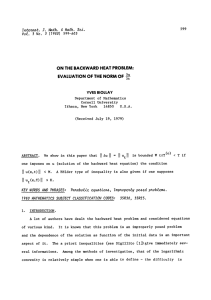
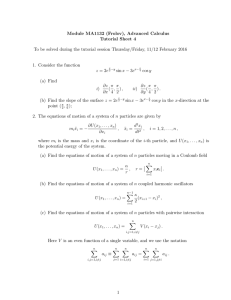

![1. Let R = C[x].](http://s2.studylib.net/store/data/010491179_1-9a9c70e395518f466f652079f02ae14a-300x300.png)

